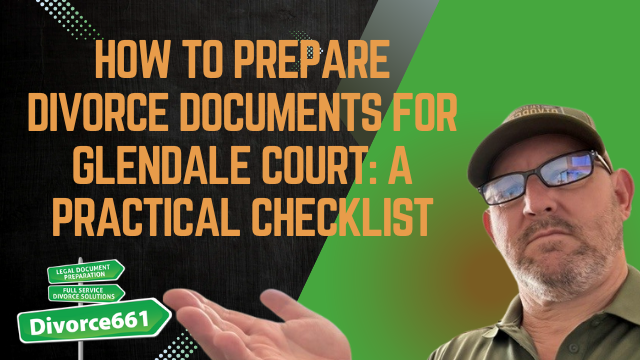How to Prepare Divorce Documents for Glendale Court: A Practical Checklist
Why accuracy matters in a Glendale divorce
Filing for divorce in Glendale requires more than filling out forms. The court enforces strict electronic filing and formatting rules, and even small mistakes can trigger rejections that cost time, money, and emotional energy. Accurate documents reduce delays, avoid unnecessary hearings, and dramatically increase the chance your judgment will be approved the first time.
Even small mistakes can lead to costly delays.
Understand Glendale’s electronic filing requirements
Glendale uses an electronic filing system that expects consistent formatting, complete attachments, and correct document naming. Courts will reject filings that don’t comply, so prepare your paperwork with the same attention you’d give a legal brief. Key expectations include legible PDF files, properly completed headers and captions, and required electronic signatures or verification pages where applicable.
Key forms every Glendale divorce needs
Most filings start with a few essential documents. Make sure each is completed accurately and double-checked before submission.
- Petition — States the grounds for divorce and basic case information.
- Summons — Notifies the other party of the pending action and their rights.
- UCCJEA (if children are involved) — Jurisdictional information for child custody across state lines.
- Financial disclosures — Includes the Schedule of Assets and Debts and Income and Expense Declaration.
- Marital Settlement Agreement (MSA) — If the parties agree, this document outlines how assets, debts, support, and custody are divided.
- Judgment package — Final judgment, proposed order, and any attachments required for court approval.
Financial disclosures: what the court expects
Full and accurate financial disclosures are central to finalizing a divorce. The Schedule of Assets and Debts and Income and Expense Declaration provide the court with the financial picture necessary for fair orders on support, property division, and fees. Missing or vague entries are common reasons for rejection.
How to prepare a judgment package correctly
The judgment package is the last step to finalize the case. If it is not formatted to the court’s specifications, it will be returned for corrections. Make sure your judgment package includes:
- Complete and signed judgment forms
- A properly prepared proposed order with correct case caption and judge information
- Proof of service and required attachments
- All required signatures and verification pages
Common pitfalls that cause rejections
These mistakes are easy to avoid but frequently cause delays:
- Incorrect or missing captions and case numbers.
- Improperly scanned documents (unreadable text, crooked pages, or large images).
- Missing financial disclosures or incomplete Schedule of Assets and Debts.
- Non-compliant proposed orders (formatting, font size, or judge/block placement).
- Failure to follow local electronic filing naming conventions or file types.
Real client example: fixing a rejected judgment
A Glendale client filed alone and had their judgment rejected twice because of formatting errors and missing disclosures. The repeated rejections delayed the finalization and caused frustration. After a professional review, the documents were corrected, properly formatted, and refiled electronically. The divorce was approved and finalized in under two weeks.
That turnaround highlights the difference between filing documents and preparing court-ready paperwork.
Tips to ensure a smooth filing
- Create a filing checklist for every document required by the court, including signatures and attachments.
- Save documents as high-quality, searchable PDFs and check that all pages are legible.
- Follow local rules for captions, margins, and proposed order formatting.
- Double-check financial disclosures for accuracy and completeness.
- Ask for a professional review if this is your first time filing or if your case includes assets, children, or support issues.
When to get professional help
Hiring experienced help can be especially valuable when the case involves property division, business interests, retirement accounts, or child custody. Professionals who prepare documents for Glendale court know the local formatting rules, electronic filing conventions, and common rejection triggers. That expertise reduces the chance of rejections and can significantly shorten the time to final judgment.
Next steps and where to get help
If preparing and filing documents feels overwhelming, consider a full-service, flat-fee option that handles everything remotely. A competent service will prepare, file, and monitor your documents so you avoid court visits, guesswork, and resubmissions. For help preparing a Glendale divorce filing or to schedule a free consultation, visit divorce661.com.
Final thought
Accuracy, proper formatting, and complete financial disclosures are the difference between a smooth divorce process and repeated rejections. Taking the time to prepare court-ready documents or enlisting proven help saves time, reduces stress, and moves you toward a final judgment faster.

